St. Baamin
Feastday: August 20
Eudoxia with (Panammon) with my sister. Martyred in Kemet. 20 Aug. Coptic Calendar.
He is a Coptic saint who was martyred in Egypt during the persecution of Christians by the Roman emperor Diocletian.
Baamin was a priest who lived in the city of Kemet (now Akhmim) in Upper Egypt. He was arrested and tortured for his faith. He was eventually beheaded.
The feast day of Saint Baamin is celebrated on August 20 by the Coptic Orthodox Church. He is also remembered by the Catholic Church on the same day.
Martyrs of Thrace
Feastday: August 20
A group of thirty-seven martyrs who suffered in Thrace, in modem northern Greece. Their feet and hands were sliced off and then they were cast into a furnace.
Saint Bernard of Clairvaux
க்ளேர்வாக்ஸ் நகர் புனிதர் பெர்னார்ட்
மடாதிபதி, ஒப்புரவாளர், மறைவல்லுநர்:
பிறப்பு: கி.பி. 1090
ஃபவுன்டைன்-லெஸ்-டிஜோன், ஃபிரான்ஸ்
இறப்பு: ஆகஸ்டு 20, 1153 (வயது 63)
க்ளேர்வாக்ஸ், ஃபிரான்ஸ்
ஏற்கும் சமயம்:
ரோமன் கத்தோலிக்க திருச்சபை
ஆங்கிலிக்கன் திருச்சபை
லூதரன் திருச்சபை
புனிதர் பட்டம்: ஜனவரி 18, 1174
திருத்தந்தை 3ம் அலெக்சாண்டர்
முக்கிய திருத்தலங்கள்:
ட்ரோய்ஸ் பேராலயம், வில்லே-சௌஸ்-ல-ஃபெர்ட்,
நினைவுத் திருநாள்: ஆகஸ்ட் 20
பாதுகாவல்:
சிஸ்டர்சியன் சபையினர் (Cistercians), பர்கண்டி (Burgundy), தேனீ வளர்ப்பவர்கள் (Beekeepers), மெழுகுவர்த்தி தயாரிப்பாளர்கள் (Candle makers), ஜிப்ரால்டர் (Gibraltar), அல்ஜீசிராஸ் (Algeciras), குயின்ஸ் கல்லூரி (Queens' College), கேம்பிரிட்ஜ் (Cambridge),
ஸ்பீயர் பேராலயம் (Speyer Cathedral), நைட்ஸ் டெம்ப்ளர் (Knights Templar), பினன்கொனம் (Binangonan), ரிஸால் (Rizal)
புனித பெர்னார்ட், ஒரு ஃபிரெஞ்ச் மடாதிபதியும் (French abbot), சிஸ்டெர்சியன் சபையின் (Cistercian order) பிரதான சீர்திருத்தவாதியும், பெனடிக்டின் துறவறத்தின் (Benedictine monasticism) சீர்திருத்தங்களின் முக்கிய தலைவருமாவார்.
பெர்னார்டின் தந்தை, “டெஸ்செலின்” (Tescelin de Fontaine), “ஃபவுன்டைன்-லெஸ்-டிஜோன்” (Fontaine-lès-Dijon) பிரபு ஆவார். இவரது தாயார், “அலேத்” (Alèthe de Montbard) ஆவார். இவர்கள் இருவமே “பர்கண்டியின்” (Burgundy) பிரபுக்கள் குடும்பத்தைச் சேர்ந்தவர்கள் ஆவர்.
தமது ஒன்பது வயதில் கல்வி கற்க ஆரம்பித்த பெர்னார்ட், இலக்கியத்தில் பெரும் ஆர்வம் கொண்டிருந்தார். கவிதைகள், செய்யுள் போன்றவற்றை எழுதுவதிலும் ஆர்வம் கொண்டிருந்தார். கல்வியில் அவர் கொண்ட வெற்றிகள், அவரது ஆசிரியர்களிடம் அவருக்கு பெரும் புகழை பெற்றுத்தந்தது. திருவிவிலியத்தை கற்கவும், ஆராய்வதற்காகவும், அவர் இலக்கியத்தில் சிறந்து விளங்க விரும்பினார். அவர், அன்னை கன்னி மரியாளிடம் சிறப்பு பக்தி கொண்டிருந்தார். பிற்காலத்தில், விண்ணரசி அன்னையைப் பற்றி பல்வேறு படைப்புகளை எழுதினர்.
தத்துவ அறிஞர்களால் ஏற்றுக்கொள்ளப்பட்ட தெய்வீக புரிதலுக்கான பகுத்தறிவு அணுகுமுறைக்கு எதிராக, பெர்னார்ட் ஒரு உடனடி விசுவாசத்தைப் பிரசங்கித்தார், அதனை பரிந்துரை செய்தது அன்னை மரியாள் ஆவார்.
பெர்னார்டுக்கு பத்தொன்பது வயதாகையில் அவரது அன்னை மரித்துப்போனார். தமது இளமைக்காலத்தில் அவர் சோதனைகளிலிருந்து தப்பிவிடவில்லை. இச்சமயத்தில், உலக நடவடிக்கைகளிலிருந்து விடுபட்டு, தனிமை மற்றும் செப வாழ்வை தேர்ந்தெடுக்க விரும்பினார். தமது 22 வயதில், ஒரு தேவாலயத்தில் அவர் செபித்துகொண்டிருக்கையில், “சிடாக்ஸ்” (Cîteaux) நகரிலுள்ள “சிஸ்டேர்சியன்” (Cistercian Monks) துறவியர் மடத்தில் இணைய கடவுள் அழைப்பதாக உணர்ந்தார். பெர்னார்டின் நண்பர்கள், சகோதரர்கள் மற்றும் உறவினர்கள் என்று சுமார் முப்பது பேர் இவருடன் சேர்ந்து துறவு மடத்தில் இணைய பெர்னார்டின் சாட்சியம் தவிர்க்க இயலாத முக்கிய காரணியாய் அமைந்தது.
மூன்று ஆண்டுகளின் பிறகு, (Val d'Absinthe) எனப்படும் தனிமைப்படுத்தப்பட்ட ஒரு ஒடுங்கிய பள்ளத்தாக்கில் துறவு மடமொன்றை நிறுவுவதற்காக அனுப்பப்பட்டார். மரபுப்படி, கி.பி. 1115ம் ஆண்டு, ஜூன் மாதம், 25ம் நாளன்று, துறவு மடத்தை நிறுவினார். அதற்கு “கிளேர் வள்ளி” (Claire Vallée) என்று பெயரிட்டார். பின்னர் அது மருவி, “க்ளேர்வாக்ஸ்” (Clairvaux) என்றானது. அங்கே, உடனடியாக விசுவாசத்தை போதித்து பிரசங்கிக்க தொடங்கினார். அதற்கு பரிந்துரையாளராக அன்னை மரியாள் இருந்தார்.
கி.பி. 1130ம் ஆண்டு, ஃபெப்ரவரி மாதம், 13ம் நாள், திருத்தந்தை “இரண்டாம் ஹானரியல்” (Pope Honorius II) மரித்ததும், திருச்சபையில் ஒரு கலகம் வெடித்தது. ஃபிரான்ஸ் நாட்டின் அரசன் “ஆறாம் லூயிஸ்” (King Louis VI of France) “எடம்ப்ஸ்” (Étampes) எனுமிடத்தில் ஃபிரெஞ்ச் ஆயர்களின் தேசிய மகாசபையைக் கூட்டினார். திருத்தந்தைப் பதவிக்கான போட்டியாளர்களிடையே தீர்ப்பு வழங்க பெர்னார்ட் தேர்ந்தெடுக்கப்பட்டார். “எடம்ப்ஸ்” (Étampes) மகா சபையின் பின்னர், திருத்தந்தை “இரண்டாம் இன்னொசன்டிற்கான” (Pope Innocent II) அரசனின் ஒதுக்கீட்டிற்காக, பெர்னார்ட் இங்கிலாந்தின் அரசன் “முதலாம் ஹென்றியுடன்” (King Henry I of England) பேச்சு நடத்தினார். இங்கிலாந்தின் பெருமளவு ஆயர்கள், எதிர் திருத்தந்தை “இரண்டாம் அனக்லெட்டஸுக்கு” (Antipope Anacletus II) ஆதரவு தெரிவித்ததால், அரசன் நம்பிக்கையற்றிருந்தார். இன்னொசன்டுக்கு ஆதரவு அளிக்குமாறு பெர்னார்ட் அரசனை வற்புறுத்தினார். பெர்னார்டின் நண்பர் “நார்பர்ட்” (Norbert of Xanten) மூலமாக, இன்னொசன்டுக்கு ஆதரவளிக்க ஜெர்மன் முடிவு செய்தது. எனினும், தூய ரோம பேரரசர் “இரண்டாம் லோதைரை” (Lothair II, Holy Roman Emperor) சந்திக்க செல்கையில் பெர்னார்ட் உடன் வரவேண்டுமென இன்னொசன்ட் வலியுறுத்தினார். திருத்தந்தைப் பதவிக்கான மொத்த யுத்தமும் கி.பி. 1138ம் ஆண்டு, ஜனவரி மாதம், 25ம் நாளன்று, “இரண்டாம் அனக்லெட்டஸ்” (Antipope Anacletus II) இறந்ததும் முடிவுக்கு வந்தது.
முன்னர் திருச்சபைக்குள்ளே ஏற்பட்ட பிரிவினைகளுக்கு முடிவுகட்ட உதவிய காரணங்களால், பெர்னார்ட் இப்போது மதங்களுக்கு எதிரான கொள்கைகளுக்கெதிராக (Heresy) போரிட அழைக்கப்பட்டார். ஜூன் 1145ல், பெர்னார்ட் தென்-ஃபிரான்ஸ் பிராந்தியங்களுக்கு பயணித்தார். அங்கே அவரது போதனைகளும் பிரசங்கங்களும் மதங்களுக்கு எதிரான கொள்கைகளுக்கெதிராக ஆதரவை அதிகரித்தது. “எடிஸ்ஸா முற்றுகையின்” (Siege of Edessa) கிறிஸ்தவ தோல்விக்குப் பிறகு, இரண்டாம் சிலுவைப்போரைப் (Second Crusade) பிரசங்கிக்க, திருத்தந்தை அவர்கள், பெர்னார்டை நியமித்தார். சிலுவைப்போரின் தோல்விகள் காரணமாக, பெர்னார்டின் வாழ்க்கையின் இறுதி ஆண்டுகள் துன்பங்கள் நிறைந்ததாக இருந்தன. தோல்விக்கான முழு பொறுப்பும் அவர் மீதே சுமத்தப்பட்டன.
40 வருடங்கள் ஒரு துறவியாக வாழ்ந்த பெர்னார்ட், தமது 63 வயதில் மரித்தார். புனிதர்களின் நாட்காட்டியில் (Calendar of Saints) இடம் பிடித்த முதல் “சிஸ்டேர்சியன்” (Cistercian) துறவி இவரேயாவார். திருத்தந்தை “மூன்றாம் அலெக்சாண்டரால்” (Pope Alexander III) புனிதராக அருட்பொழிவு செய்விக்கப்பட்ட இவர், திருத்தந்தை “எட்டாம் பயசால்” (Pope Pius VIII) கி.பி. 1830ம் ஆண்டு திருச்சபையின் மறைவல்லுனராக (Doctor of the Church) பிரகடணம் செய்யப்பட்டார்.
Also known as
• Mellifluous Doctor of the Church
• Last of the Fathers of the Holy Church
Profile
Born to the French nobility; brother of Saint Humbeline. At age 22, fearing the ways of the world, he, four of his brothers, and 25 friends joined the abbey of Citeaux; his father and another brother joined soon after. Benedictine. Founded and led the monastery of Clairvaux which soon had over 700 monks and eventually 160 daughter houses. Revised and reformed the Cistercians. Advisor to, and admonisher of, King Louis the Fat and King Louis the Young. Attended the Second Lateran Council. Fought Albigensianism. Helped end the schism of anti-Pope Anacletus II. Preached in France, Italy, and Germany. Helped organize the Second Crusade. Friend and biographer of Saint Malachy O'More. Spritual advisor to Pope Eugene III, who had originally been one of his monks. First Cistercian monk placed on the calendar of saints. Proclaimed a Doctor of the Church by Pope Pius VIII.
Every morning Bernard would ask himself, "Why have I come here?", and then remind himself of his main duty - to lead a holy life.
Born
1090 at Fontaines-les-Dijon, Burgundy, France
Died
20 August 1153 at Clairvaux Abbey, Ville-sous-la-Ferté, Aube, France
Canonized
1170 by Pope Alexander III
Blessed Teofilius Matulionis
Profile
The middle of three brothers born to the peasant family of Jurgis Matulionis and Ona Juocepyte; after his mother died, his father re-married, and the couple then had seven more children. Teofilius studied at Antaliepte, Lithuania from 1887 to 1892, then Dvinsk (modern Daugpilis, Latvia) from 1892 to 1900, and then at the seminary in Saint Petersburg, Russia; he could speak Russian, Latvian and Polish. At one point he questioned his vocation, left seminary, and supported himself by teaching, but later returned to seminary. Ordained a priest of the diocese of Mohilev, Belarus on 17 March 1900.
He assisted briefly in several parishes in Latvia, and on 26 June 1900 was assigned to Latgalia, Latvia. From 1910 to 1929 he was assigned to the parish of the Sacred Heart of Jesus in Saint Petersburg, an area where Catholics were a distinct minority, and where they came under increased persecution following the Communist takeover of Russia. The Bolsheviks confiscated all churches in 1922. Father Teofilius was imprisoned from 1923 to 1925 for failure to cooperate with the Soviets in the persecution of Archbishop Jan Cieplak.
Chosen Auxiliary Bishop of Mohilev, Belarus and Titular Bishop of Matrega by Pope Pius XI on 8 December 1928, he was consecrated in secret on 7 February 1929. On 24 November 1929 he was arrested and sentenced to hard labour in a prison camp north of Arctic Circle for the crime of having had contact with people outside the Soviet Union. In prison he would often get up in the middle of the night to celebrate Mass in secret, distributing the Eucharist to other prisoners when possible. The privations of the prison broke his health; Father Teofilius was re-located to solitary confinement in a prison in Saint Ptersburg and finally turned over to Lithuania as part of a prisoner exchange.
Chosen Archbishop of Kaisiadorys, Lithuania on 9 January 1943 by Pope Pius XII. In 1946 he released a pastoral letter to his diocese; the Soviet authorities imprisoned him for ten years for actively practising his vocation. Released in 1956, he was placed under house arrest in Birstonas, Lithuania to prevent his returning to active work as a bishop. On 25 December 1957 Matulionis consecrated Vincentas Sladkevicius a bishop without the consent of the Communists. The authorities mocked him for celebrating the consecration is his kitchen; Matuliones shamed them for forcing him to such a reduced state. For his disobediance, the Communists exiled him to Seduva, Lithuania for the rest of his life. Martyr.
Born
22 June 1873 in Alantos, Moletai, Russian Empire (in modern Lithuania)
Died
• during a routine search of his apartment by Soviet authorities, he was given an injection by a KGB nurse and dropped dead on 20 August 1962 in Seduva, Radviliskis, Lithuania
• his body was exhumed and autopsied in 1999; tests indicated that he had been poisoned
• interred in the crypt of the Transfiguration Cathedral of Kaisiadorys, Kaisiadorys, Kaisiadorys District Municipality, Kaunas, Lithuania
Beatified
• 25 June 2017 by Pope Francis
• beatification celebrated at the square of the Cathedral Basilica of Sventasis Stanislovas ir Sventasis Vladislovas, Vilnius, Lithuania, presided by Cardinal Angelo Amato
• it was the first beatification celebrated in Lithuania
• it was the first beatification of a Lithuanian martyred by Communists
Saint Maria de Mattias
Profile
Born to a pious and educated upper class family. Though women of her day were forbidden a formal education, she learned to read and write, and much about her faith at home from her father. Being an upper class girl of the time, she grew up isolated and self-involved, but in her mid-teens she felt the hollowness of her life, and began to search for more meaning. She prayed for enlightment and received a mystical vision that led her to leave home and wander the roads, explaining the love of God to any who would listen.
At age 17 she attended a mission preached by Saint Gaspare de Bufalo, and saw the obvious changes to people who attended. She wanted to have the same effect, and with the aid of Venerable Giovanni Merlini she founded the Congregation of the Sisters Adorers of the Blood of Christ in Acuto, Italy on 4 March 1834, a woman's congregation for teaching girls. She expanded their work to teaching and catechizing women and boys. Though, due to the social mores of the time she was not allowed to speak to men, they would often gather on their own, sometimes in hiding, to listen to her teaching. Pope Pius IX assigned her to running the San Luigi Hospice in Rome, and from there she worked to expand the Adorers. The congregation experienced occasional opposition from the clergy, but always support from the laity; they ran 70 schools by Mary's death, most in small isolated towns, and over 400 by her beatification.
Born
4 February 1805 at Vallecorsa, Frosinone, Papal States (modern Italy)
Died
• 20 August 1866 in Rome, Italy of natural causes
• buried in the Verano cemetery, Rome
• relics venerated in Rome at the Church of the Precious Blood
Canonized
18 May 2003 by Pope John Paul II at Vatican Basilica
Saint Zacchaeus the Publican
Also known as
Zaccheo
Additional Memorials
• 20 April (Coptic calendar)
• 32nd Sunday after Pentecost (Byzantine calendar)
• 27 August (Martyrology of Rabban Sliba)
Profile
Mentioned in Gospel of Luke as the short tax collector who climbed a tree in order to see Jesus because he couldn't see over the crowd. Jesus decided to go to the man's house, and when the locals grumbled that Christ was friendly with sinners, Zacchaeus showed his conversion by making retribution to any he had harmed, and by giving largely to charity.
Since that's all we actually know, many legends have grown around him, including that he married Saint Veronica, that he became bishop of Caesarea in Palestine, and that he is Saint Amadour who was an early hermit in France.
Patronage
innkeepers (the word publican formerly meant a collector of taxes from the public; in English it later meant the proprietor of a public house, pub or inn
Saint Oswine of Deira
Also known as
Osuine, Oswin
Profile
Born a prince, the son of King Osric of Deira in Britain. Educated by Saint Aidan. Succeeded Saint Oswald of Northumbria as king of Deira in 642. Saint Bede describes him as "most generous to all men and above all things humble; tall of stature and of graceful bearing, with pleasant manner and engaging address." While his reign was one of peace and order, there was constant political wrangling with his cousin Oswy who desired the throne and eventually had him murdered.
Died
• murdered 20 August 651 at Gilling, Yorkshire, England on the orders of his cousin Oswy
• initially buried at Gilling
• re-interred at Tynemouth
• his gravesite was lost during the turmoil of the Viking invasions
• grave re-discovered in 1065 following an apparition of Oswine to a monk named Edmund
• relics moved on 11 March 1100
• relics moved on 20 August 1103
• following the dissolution of monasteries by King Henry VIII, relics moved to Durham, England
Patronage
betrayal victims (his location was betrayed to his murders by a one of his supposedly loyal nobles)
Saint Philibert of Jumièges
Profile
The only son of a member of the court of King Dagobert I. Educated by Saint Ouen of Rouen. Monk of Rébais Abbey at age 20. Abbot of Rébais. He spent some time travelling to various monasteries, studying their Rules, constitutions and methods of mangement. Founded Jumièges Abbey on land he received as a gift from King Clovis II. He created a Rule for the Abbey, and served as its first abbot. Imprisoned and then exiled for opposition to Ebroin. Founded the monastery of Noirmoutier. Abbot of Luçon Abbey. Returning from exile, he founded the monastery of Cunaut and a convent at Pavilly, and helped restore Quinçay. The filbert, or hazelnut, is said to have been named for him as it ripens in England around the time of his feast day.
Born
c.608 in Gascony, France
Died
• 684 on the island of Héri, France of natural causes
• interred in Noirmoutier Abbey
• when the monks abandoned Noirmoutier in 836 due to Viking invasion, they took Philibert's relics with them
• the relics were housed in five different abbeys during the next 39 years
• relics moved to the Saint Philibert Abbey in Tournus, France in 875
Blessed Manuel López Álvarez
Profile
Born to a peasant family, Manuel was baptized on the day he was born. Ordained as a priest in the archdiocese of Granada, Spain on 16 July 1905. Parish priest in Alcolea, Spain. In the time leading up to the Spanish Civil War, Father Manuel came increasingly in conflict with anti–Catholic elements – he had a shotgun pulled on him for officiating at a funeral, and had to sleep in his church to run off would-be arsonists. On 20 August 1936, he was reported by Communist sympathizers to the militia who seized him along with eight other Catholics. The group was loaded into a truck, driven to a cemetery and murdered. Martyr.
Born
26 March 1881 in Mairena, Granada, Spain
Died
• shot, dragged to a pit, and then his skull crushed with a gravedigger's tool on 20 August 1936 at the cemetery in Berja, Almeria, Spain
• buried in a mass grave in Berja with other murdered Catholics
Beatified
• 25 March 2017 by Pope Francis
• beatification celebrated in the Palacio de Exposiciones y Congresos de Aguadulce, Almería, Spain, presided by Cardinal Angelo Amato
Saint Bernardo Tolomei
Also known as
• Bernard Ptolomei
• Bernard Tolomeo
• Giovanni Tolomeo
Profile
Giovannni early changed his name to Bernard from admiration for Bernard of Clairvaux. Educated by his Dominican uncle. His father prevented Bernard from entering religious life. Lawyer. Theologian. Soldier. Politician and government official. Struck blind, Bernardo recovered his sight through the intervention of the Blessed Virgin Mary, after which he gave up worldly life to become a hermit. Accused of heresy, Bernard soon cleared his name. Priest. Founder of the Benedictine Congregation of the Blessed Virgin of Monte Oliveto (Olivetan Congregation; Olivetans). During a bout of the plague, Bernard and his monks cared for any who needed it; none of the brothers became sick.
Born
10 May 1272 at Siena, Tuscany as Giovanni Tolomei
Died
20 August 1348 in Siena, Italy of natural causes
Beatified
24 November 1644 by Pope Innocent X (cultus confirmed)
Canonized
26 April 2009 Pope Benedict XVI
Saint Amadour the Hermit
Also known as
• Amadour of Lucca
• Amadour of Rocamadour
• Amadoro, Amator, Amatore
Profile
In 1126 or 1162 (record vary), the body of this saint was found, possibly incorrupt, in a tomb with indications that the person had died about 1000 years earlier. With no background information available about the body, a series of stories (and guesses) grew up around the person –
• he was Saint Zacchaeus the Publican who changed his name when he converted to Christianity
• he was a servant in the house of the Holy Family
• he was married to Saint Veronica
• he and Saint Veronica served as missionaries in the area of Bordeaux, France
• he was in Rome, Italy to witness the martyrdoms of Paul and Peter
• upon the death of Veronica, he became the first Christian hermit of Gaul with a cell at Quircy, France
• he built the Our Lady of Rocamadour shrine and pilgimage site in France
Died
some relics enshrined at the Saint Michelotto Franciscan convent
Blessed Enrique Rodríguez Tortosa
Profile
Orphaned when he was very small, Enrique was raised by his aunt Araceli. He grew to be a pious and committed Christian, an honest, humble and well-liked layman in his community in the diocese of Almería, Spain. Member of Catholic Action. When Communist militia came to his down in the Spanish Civil War, they ordered Enrique to renounce Christianity; he refused. They seized him, threw him into truck, drove him out of the village and murdered him. Martyr.
Born
30 April 1908 in Terque, Almería, Spain
Died
20 August 1936 in La Rambla de Gérgal, Almería, Spain
Beatified
• 25 March 2017 by Pope Francis
• beatification celebrated in the Palacio de Exposiciones y Congresos de Aguadulce, Almería, Spain, presided by Cardinal Angelo Amato
Blessed José Tapia Díaz de Villachica
Profile
Young layman in the diocese of Almería, Spain, he was the son of merchants and early began working as a clerk to learn the family trade. Member of Catholic Action. Martyred in the Spanish Civil War for refusing to renounce his faith.
Born
6 January 1913 in Terque, Almería, Spain
Died
20 August 1936 in La Rambla de Gérgal, Almería, Spain
Beatified
• 25 March 2017 by Pope Francis
• beatification celebrated in the Palacio de Exposiciones y Congresos de Aguadulce, Almería, Spain, presided by Cardinal Angelo Amato
Blessed María Climent Mateu
Profile
Lay woman in the archdiocese of Valencia, Spain, she was baptized on the day of her birth at her parish church of Saint Tecla. Educated by the Dominican Sisters in Valencia, Spain. Singer, musician and loved to work on embroidery. Secretary of the Catholic Women's Trade Union. Member of the Society of Saint Vincent de Paul. Martyred in the Spanish Civil War; her dying words - "Viva Christo Rey!" (Long live Christ the King!)
Born
30 May 1887 in Xàtiva, Valencia, Spain
Died
stabbed to death on 20 August 1936 in Picadero de Paterna, Valencia, Spain
Beatified
11 March 2001 by Pope John Paul II
Blessed Wladyslaw Maczkowski
Also known as
Ladislaus Maczkowski
Additional Memorial
12 June as one of the 108 Martyrs of World War II
Profile
Priest in the Archdiocese of Gniezno, Poland, serving in the parish of Lubowo. Arrested on 26 August 1940 by occupying Nazis, he was imprisoned in the Dachau concentration camp where he ministered to fellow prisoners and was abused by guards for nearly two years. Martyr.
Born
24 June 1911 in Ociaz, Wielkopolskie, Poland
Died
20 August 1942 in the Dachau concentration camp, Oberbayern, Germany
Beatified
13 June 1999 by Pope John Paul II
Saint Ronald of Orkney
புனித ரொனால்ட்
இவர் ஸ்காட்லாந்து நாட்டிற்கு அருகில் உள்ள ஓர்க்னே தீவை சார்ந்தவர்.
சிறு வயதிலேயே இறைவன்மீது மிகுந்த பற்றுக்கொண்டு, துடிப்போடு இருந்த இவர், பின்னாளில் இராணுவ வீரராக மாறி, நாட்டிற்காகப் பணிபுரியத் தொடங்கினார்.
"எங்களுடைய பகுதியில் கோயிலே இல்லை" என்று மக்கள் மிகவும் வருந்திக் கொண்டிருந்த வேளையில், இவர் "நான் உங்களுக்கு ஒரு கோயிலைக் கட்டித் தருகிறேன்" என்று வாக்குறுதி தந்து, ஒரு கோயிலைத் கட்டித் தந்தார்.
அவ்வாறு இவர் கட்டித்தந்த கோயில் தான் கிர்க்வால் என்ற இடத்தில் உள்ள புனித மாக்னுஸ் பெருங்கோயில் ஆகும். இவர் தான் சொன்னது போன்றே ஒரு கோயிலைக் கட்டி தந்ததால், மக்கள் இவரை உயர்வாக மதிக்கத் தொடங்கினார்கள்.
இதன் பிறகு இவர் கடவுள்மீது இன்னும் மிகுதியான நம்பிக்கையோடு வாழத் தொடங்கினார்.
ஒருமுறை நாத்திகர்கள் சிலர் இவரைக் கிறிஸ்துவை மறுதலிக்க சொன்னார்கள். அதற்கு இவர், "எனது உயிரே போனாலும் நான் கிறிஸ்துவை ஒருபோதும் மறுதலிக்க மாட்டேன்" என்று சொல்லி தன்னுடைய நம்பிக்கையில் மிக உறுதியாக இருந்தார். இதனால் அவர்கள் வெகுண்டெழுந்து இவரைக் கொலை செய்தார்கள்
Also known as
• Rögnvald Kali Kolsson
• Ragnvald Kale Kollsson
Profile
Son of Lendmann Kol Kalisson and Gunhild Erlendsdotter, and described as "elegant and accomplished". Appointed Earl of the Orkney and Shetland Islands by King Sigurd I of Norway in 1129. He made a vow to build a church in his lands; the result was the Saint Magnus Cathedral in Kirkwall, Scotland. Murdered by a group of warriors rebelling against him, his rule and his religion, and is considered a martyr in Kirkwall.
Born
1100 in Norway
Died
20 August 1158 in Caithness, Scotland
Canonized
1192 by Pope Celestine III
Blessed Matías Cardona-Meseguer
Also known as
Matías of Saint Augustine
Profile
Son of Narciso Cardona and Domenica Meseguer. Soldier. Joined the Piarists on 25 June 1929, and made his solemn profession on 15 August 1934. Priest, ordained on 11 April 1935. Served in Barcelona, Spain. Martyred in the Spanish Civil War.
Born
23 December 1902 in Vallibona, Castellón, Spain
Died
shot on 20 July 1936 in Pigro de Coll, Vallibona, Castellón, Spain
Beatified
1 October 1995 by Pope Saint John Paul II
Samuel the Patriarch
Profile
The last Judge of Israel, described in the Old Testament book of 1 Kings. The son of Elcana and Hannah, who vowed before his birth to give him to God. Delivered the Israelites from the rule of the Philistines (1 Kings 7). Believed by some to be the author of the books of Judges and Ruth, and the first 24 verses of 1 Kings. In his old age he appointed his sons judges over Israel, but they displeased the ancients, who asked him for a king, and the Lord told him to anoint Saul (1 Kings 8).
Born
c.1132 BC at Ramatha in the moutains of Ephraim
Blessed Gervais-Protais Brunel
Profile
Trappist monk. Priest. Imprisoned on a ship in the harbor of Rochefort, France and left to die during the anti-Catholic persecutions of the French Revolution. One of the Martyrs of the Hulks of Rochefort.
Born
18 June 1744 in Magnières, Meurthe-et-Moselle, France of typhus
Died
20 August 1794 aboard the prison ship Deux-Associés, in Rochefort, Charente-Maritime, France
Beatified
1 October 1995 by Pope John Paul II
Blessed Louis-François Lebrun
Profile
Benedictine Maurist priest. Imprisoned on a ship in the harbor of Rochefort, France and left to die during the anti-Catholic persecutions of the French Revolution. One of the Martyrs of the Hulks of Rochefort.
Born
4 April 1744 in Rouen, Seine-Maritime, France
Died
20 August 1794 aboard the prison ship Deux-Associés, in Rochefort, Charente-Maritime, France
Beatified
1 October 1995 by Pope John Paul II
Saint Laura of Pollenza
Profile
Martyred in the persecutions of Diocletian.
Died
• beheaded in the early 4th century in Rome, Italy
• buried in the Roman catacombs
• relics exhumed on 4 January 1846 and enshrined in the church of Santa Maria del Trebbio, near the Franciscan convent of Pollenza, Italy
• relics re-enshrined in an urn on 27 May 1889 in the Collegiate Church of San Biagio
• relics re-enshrined in May 1912
Blessed Georg Häfner
Also known as
Georg Haefner
Profile
Priest in the diocese of Würzburg, Germany. Arrested by the Nazis and sent to die in the concentration camps for his faith. Martyr.
Born
19 October 1900 in Würzburg, Germany
Died
20 August 1942 in Dachau, Oberbayern, Germany
Beatified
15 May 2011 by Pope Benedict XVI
Saint Lucius of Cyprus
Profile
4th century imperial Roman government official in Cyrene, Africa. He witnessed the faith and martyrdom of Saint Theodore of Cyrene, which led to interest in Christianity and eventually his conversion. Retired to the island of Cyprus to live away from the empire, but was one of a group of Christians martyred in the persecutions of Diocletian.
Died
311 on Cyprus
Blessed Francesco Matienzo
Profile
Mercedarian friar who worked to free Christians held in slavery in Spain by Muslims; he freed 185 of them in 1371.
Died
latter 14th century
Saint Edbert of Northumbria
Profile
King of Northumbria, England for 20 years after which he abdicated and retired to spent his last ten years in prayer and seclusion in a monastery in York, England.
Died
768
Saint Bernard of Valdeiglesias
Also known as
Bernard of Candeleda
Profile
Benedictine Cistercian monk.
Died
1155 of natural causes
Patronage
Candelada, Spain
Saint Christopher of Cordoba
Profile
Monk at the Saint Martin de La Rojana monastery near Cordoba, Spain. Martyred in the persecutions of Abderrahman II.
Died
852 in Cordoba, Spain
Saint Haduin of Le Mans
Also known as
Harduin
Profile
Bishop at Le Mans, France. Founded several monasteries including Notre-Dame-d'Evron.
Died
c.662 of natural causes
Saint Burchard of Worms
Profile
Monk at Lobbes Abbey in Belgium. Canonist. Reluctant bishop of Worms, Germany in 1006.
Born
Hesse, Germany
Died
1026
Saint Heliodorus of Persia
Profile
Martyred with several hundred companions during the persecutions of Shapur II.
Born
Persia
Died
362
Saint Herbert Hoscam
Profile
Archbishop of Conze, Basilicata, Italy.
Born
in England
Died
1180 of natural causes
Patronage
Conze, Italy
Saint Gobert of Apremont
Profile
Count of Apremont. Crusader. Benedictine Cistercian monk at Villers, Brabant, Belgium.
Died
1263 of natural causes
Saint Leovigild of Cordoba
Profile
Priest. Monk in Cordoba, Spain. Martyred in the persecutions of Abderrahman II.
Died
852 in Cordoba, Spain
Saint Maximus of Chinon
Profile
Spiritual student of Saint Martin. Founded the monastery of Chinon in France.
Died
c.470
Saint Porphyrius of Palestrina
Profile
Martyr.
Died
in Palestrina, Italy
Saint Brogan
Profile
Mentioned in the Gorman Martyrology.
Martyred in the Spanish Civil War
Thousands of people were murdered in the anti-Catholic persecutions of the Spanish Civil War from 1934 to 1939.
• Blessed Cristòfol Baqués Almirall
• Blessed Emili Bover Albareda
• Blessed Francesc Llagostera Bonet
• Blessed Hilario Barriocanal Quintana
• Blessed Ismael Barrio Marquilla
• Blessed Magí Albaigés Escoda
• Blessed Serapio Sanz Iranzo
• Blessed Tomás Campo Marín
Benedicto Zafont
Benedicto Zafont was the 45th Master General of the Mercedarian Order. He was born in Valencia, Spain, in 1444. He joined the Mercedarian Order in 1464 and was ordained a priest in 1470.
Zafont was elected Master General of the Mercedarian Order in 1497. He served as Master General for 22 years, until his death in 1519. During his time as Master General, he reformed the order and strengthened its mission of ransoming Christian captives from Muslim captivity.
Zafont is also known for his writings on the Mercedarian Order. He wrote a history of the order, as well as a number of spiritual treatises.
Zafont is considered a saint by the Mercedarian Order. His feast day is celebrated on August 20.












































